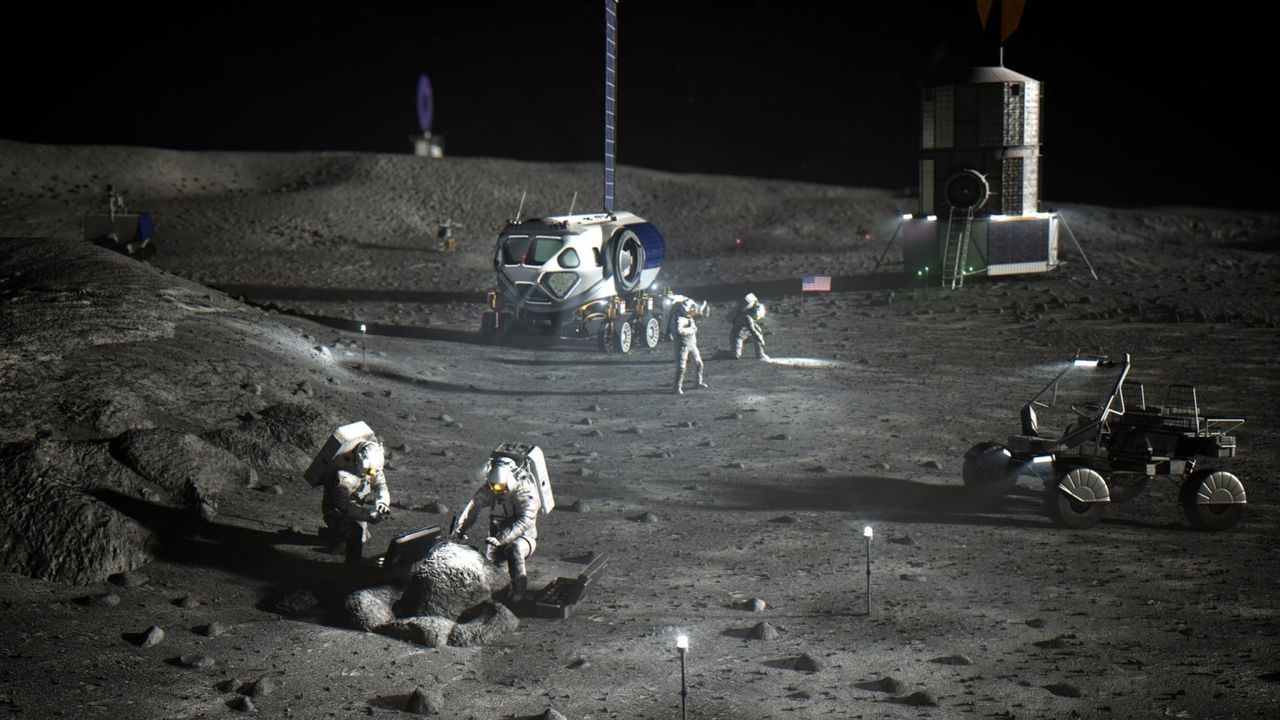By Erin McCarthy

Tom Hanks, Ayelet Zurer, Thure Lindhart and Ewan McGregor in Columbia Pictures' suspense thriller Angels & Demons.
Angels & Demons science was a main concern to director Ron Howard, says Dr. Rolf Landua, a CERN scientist who worked closely with Howard. "We had a long discussion, almost the whole day," Landua says, "about how the science in the movie could be made as authentic as possible."
In Angels & Demons, scientists at CERN use the Large Hadron Collider to create one gram of a highly volatile substance called antimatter, which they store in electromagnetic traps. The plot is set in motion when a secret scientific society known as the Illuminati steals the antimatter; the organization’s goal is to use it to destroy the Vatican during the selection of a new Pope.
Antimatter is a real substance, first theorized in 1928. "Every time you squeeze a lot of energy into a small space, you produce equal amounts of matter and antimatter," Landua explains. "Nature doesn’t like to create just one sort; it always produces both to keep a balance. I compare it to digging a hole in the sand, and then you have a pile next to it. You can’t do one without the other." The first antielectron was produced in 1932, and particle accelerators helped scientists create the first antiproton in 1955. Antimatter was first produced at CERN in 1995, though not by the Large Hadron Collider (LHC). But unlike in the movie—where CERN has produced a gram of antimatter—the facility has actually only produced a small amount of the substance. "In the movie, we switch on the LHC and it produces a gram of antimatter in a few minutes," Landua says. "That’s not possible for two reasons: It would need much more energy to do it—with present efficiency, it would take 10 ^ 22 joules—and the reality of how quickly antimatter can be produced … it would take about a billion years to produce a gram. We can make about a billionth of a gram in a year."
According to Landua, Howard chose the LHC as the particle accelerator where the antimatter is produced because the 25 meter tall, 42 meter long machine is visually dynamic. In reality, the antimatter that CERN has produced wasn’t made in the LHC. The LHC has not carried out any atom collisions yet—CERN hopes to begin using it as soon as September of this year—and at any rate, the antimatter moving in that machine will move too quickly to capture. "In order to attract and store antimatter, you have to slow it down to very low speeds," he says. "When you have a mouse, it’s easier to trap it when it moves slowly, but it’s not so easy when the mouse is moving at the speed of light. The particles made in the LHC are so energetic that they will hit the walls of the chamber and annihilate." Landua’s 2002 experiment, ATHENA, produced millions of slow-moving antiatoms (specifically antihydrogen) in CERN’s Antiproton Decelerator with the goal of capturing it, but they haven’t reached that goal quite yet. "Antihydrogen is neutral and difficult to handle," Landua says. "People are working on it."
Some types of antimatter have been trapped in devices much like the one in the film, which uses electromagnetism to keep the antimatter floating in an airtight container. "It has to be a very good vacuum so the antimatter doesn’t touch anything," Landua says. "The suspension would be done with electromagnetic fields." Scientists at CERN used a device called a Penning trap to store electrically charged antiprotons for 57 days. But transportation of antimatter, while theoretically possible, hasn’t been done yet. "That’s a bit of a jump into the future," Landua says.
The rapidly dissipating battery of the antimatter trap in Angels & Demons is of particular concern because when antimatter comes into contact with matter, the two annihilate. "They set free the energy that’s stored in the mass," Landua explains. "A little bit of mass contains enormous amounts of energy. Normally it’s very safe, stored in the form of mass—you can’t unlock the energy. But matter and antimatter together unlock the energy and set it free." In the film, a gram of antimatter is as powerful as a 5-kiloton nuclear bomb. But in real life, "there has never been enough antimatter made to have anything like that."
Still, the explosion we see in the film is pretty accurate, and so is the damage it does—a tweak from the book, where virtually nothing was damaged in the annihilation. "Basically, what you’re doing is bumping a lot of energy into a small space," Landua explains. "That’s not entirely different from what you do in atomic weapons. There’s an ultrahot, dense core, which expands and produces radiation, and then there’s an acoustic blast, and it would produce a lot of damage."
Overall, Landua is pleased with how science is portrayed in Angels & Demons. "Ron really made a serious effort to get this right," he says. "He was very conscientious about the possible pitfalls. Tom Hanks and Ayelet Zurer were very interested in what we were doing—they asked lots of question about antimatter and higgs particle. It was quite impressive." Plus, the researcher sees no harm in taking some scientific liberties. After all, "it’s a film, not a textbook." When Ron Howard took on Dan Brown’s, author of The Da Vinci Code, earlier novel Angels & Demons, one of the first things he did was visit the European Organization for Nuclear Research, or CERN, where a portion of the book takes place. But did his scientific research pay off? PM’s Digital Hollywood has the full story. Warning: spoilers ahead.
By Erin McCarthy

Tom Hanks, Ayelet Zurer, Thure Lindhart and Ewan McGregor in Columbia Pictures' suspense thriller Angels & Demons.
Angels & Demons science was a main concern to director Ron Howard, says Dr. Rolf Landua, a CERN scientist who worked closely with Howard. "We had a long discussion, almost the whole day," Landua says, "about how the science in the movie could be made as authentic as possible."
In Angels & Demons, scientists at CERN use the Large Hadron Collider to create one gram of a highly volatile substance called antimatter, which they store in electromagnetic traps. The plot is set in motion when a secret scientific society known as the Illuminati steals the antimatter; the organization’s goal is to use it to destroy the Vatican during the selection of a new Pope.
Antimatter is a real substance, first theorized in 1928. "Every time you squeeze a lot of energy into a small space, you produce equal amounts of matter and antimatter," Landua explains. "Nature doesn’t like to create just one sort; it always produces both to keep a balance. I compare it to digging a hole in the sand, and then you have a pile next to it. You can’t do one without the other." The first antielectron was produced in 1932, and particle accelerators helped scientists create the first antiproton in 1955. Antimatter was first produced at CERN in 1995, though not by the Large Hadron Collider (LHC). But unlike in the movie—where CERN has produced a gram of antimatter—the facility has actually only produced a small amount of the substance. "In the movie, we switch on the LHC and it produces a gram of antimatter in a few minutes," Landua says. "That’s not possible for two reasons: It would need much more energy to do it—with present efficiency, it would take 10 ^ 22 joules—and the reality of how quickly antimatter can be produced … it would take about a billion years to produce a gram. We can make about a billionth of a gram in a year."
According to Landua, Howard chose the LHC as the particle accelerator where the antimatter is produced because the 25 meter tall, 42 meter long machine is visually dynamic. In reality, the antimatter that CERN has produced wasn’t made in the LHC. The LHC has not carried out any atom collisions yet—CERN hopes to begin using it as soon as September of this year—and at any rate, the antimatter moving in that machine will move too quickly to capture. "In order to attract and store antimatter, you have to slow it down to very low speeds," he says. "When you have a mouse, it’s easier to trap it when it moves slowly, but it’s not so easy when the mouse is moving at the speed of light. The particles made in the LHC are so energetic that they will hit the walls of the chamber and annihilate." Landua’s 2002 experiment, ATHENA, produced millions of slow-moving antiatoms (specifically antihydrogen) in CERN’s Antiproton Decelerator with the goal of capturing it, but they haven’t reached that goal quite yet. "Antihydrogen is neutral and difficult to handle," Landua says. "People are working on it."
Some types of antimatter have been trapped in devices much like the one in the film, which uses electromagnetism to keep the antimatter floating in an airtight container. "It has to be a very good vacuum so the antimatter doesn’t touch anything," Landua says. "The suspension would be done with electromagnetic fields." Scientists at CERN used a device called a Penning trap to store electrically charged antiprotons for 57 days. But transportation of antimatter, while theoretically possible, hasn’t been done yet. "That’s a bit of a jump into the future," Landua says.
The rapidly dissipating battery of the antimatter trap in Angels & Demons is of particular concern because when antimatter comes into contact with matter, the two annihilate. "They set free the energy that’s stored in the mass," Landua explains. "A little bit of mass contains enormous amounts of energy. Normally it’s very safe, stored in the form of mass—you can’t unlock the energy. But matter and antimatter together unlock the energy and set it free." In the film, a gram of antimatter is as powerful as a 5-kiloton nuclear bomb. But in real life, "there has never been enough antimatter made to have anything like that."
Still, the explosion we see in the film is pretty accurate, and so is the damage it does—a tweak from the book, where virtually nothing was damaged in the annihilation. "Basically, what you’re doing is bumping a lot of energy into a small space," Landua explains. "That’s not entirely different from what you do in atomic weapons. There’s an ultrahot, dense core, which expands and produces radiation, and then there’s an acoustic blast, and it would produce a lot of damage."
Overall, Landua is pleased with how science is portrayed in Angels & Demons. "Ron really made a serious effort to get this right," he says. "He was very conscientious about the possible pitfalls. Tom Hanks and Ayelet Zurer were very interested in what we were doing—they asked lots of question about antimatter and higgs particle. It was quite impressive." Plus, the researcher sees no harm in taking some scientific liberties. After all, "it’s a film, not a textbook."







































.jpg)




























































